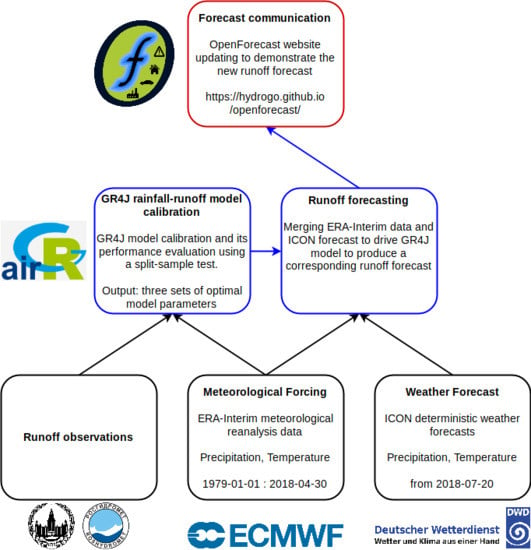OpenForecast: The First Open-Source Operational Runoff Forecasting System in Russia
Abstract
1. Introduction
2. Materials and Methods
2.1. Study Area and the Choice of Pilot Basins
2.2. Meteorological Data
2.3. Runoff and Water Level Observations
2.4. Hydrological Model
2.5. Openforecast Computational Framework
3. Results and Discussion
3.1. Hydrological Model Calibration and Evaluation on a Historical Period
3.2. Operational Runoff Forecasting with OpenForecast
3.3. Operational Use of OpenForecast in CAHEM
3.4. Communication of Forecasts
4. Conclusions
- Scientific development. As initial evaluation results indicated some problems in flood prediction efficiency, we want to understand the possible sources of OpenForecast errors better.
- Software development and service maintenance. Under this direction, we plan to migrate from ERA-Interim to ERA-5 meteorological reanalysis data (both produced by ECMWF), from deterministic (ICON) to ensemble weather forecast product (ICON-EPS) of DWD, and from the one hydrological model (GR4J) to the family of GR models (e.g., GR5J, GR6J). We also want to document and then share OpenForecast code to engage the hydrological community in further development.
- Communication of forecast. We want to promote OpenForecast to a broader audience: both specialist and non-specialist should be able to benefit from our service to make informed decisions.
- OpenForecast expansion. As OpenForecast requires only historical runoff observations and watershed boundaries as input for initialization of operational forecasting routine, we want to expand our service for as many basins as satisfy these conditions disregarding their location.
Author Contributions
Funding
Acknowledgments
Conflicts of Interest
References
- CRED. Natural Disasters 2017. 2018. Available online: https://cred.be/sites/default/files/adsr_2017.pdf (accessed on 24 July 2019).
- Matte, S.; Boucher, M.A.; Boucher, V.; Fortier Filion, T.C. Moving beyond the cost–loss ratio: Economic assessment of streamflow forecasts for a risk-averse decision maker. Hydrol. Earth Syst. Sci. 2017, 21, 2967–2986. [Google Scholar] [CrossRef]
- Pappenberger, F.; Cloke, H.L.; Parker, D.J.; Wetterhall, F.; Richardson, D.S.; Thielen, J. The monetary benefit of early flood warnings in Europe. Environ. Sci. Policy 2015, 51, 278–291. [Google Scholar] [CrossRef]
- Alfieri, L.; Burek, P.; Dutra, E.; Krzeminski, B.; Muraro, D.; Thielen, J.; Pappenberger, F. GloFAS-global ensemble streamflow forecasting and flood early warning. Hydrol. Earth Syst. Sci. 2013, 17, 1161–1175. [Google Scholar] [CrossRef]
- Emerton, R.; Zsoter, E.; Arnal, L.; Cloke, H.L.; Muraro, D.; Prudhomme, C.; Stephens, E.M.; Salamon, P.; Pappenberger, F. Developing a global operational seasonal hydro-meteorological forecasting system: GloFAS-Seasonal v1. 0. Geosci. Model Dev. 2018, 11, 3327–3346. [Google Scholar] [CrossRef]
- Bierkens, M.F.; Bell, V.A.; Burek, P.; Chaney, N.; Condon, L.E.; David, C.H.; de Roo, A.; Döll, P.; Drost, N.; Famiglietti, J.S.; et al. Hyper-resolution global hydrological modelling: What is next? “Everywhere and locally relevant”. Hydrol. Process. 2015, 29, 310–320. [Google Scholar] [CrossRef]
- Cloke, H.; Pappenberger, F. Ensemble flood forecasting: A review. J. Hydrol. 2009, 375, 613–626. [Google Scholar] [CrossRef]
- Emerton, R.E.; Stephens, E.M.; Pappenberger, F.; Pagano, T.C.; Weerts, A.H.; Wood, A.W.; Salamon, P.; Brown, J.D.; Hjerdt, N.; Donnelly, C.; et al. Continental and global scale flood forecasting systems. Wiley Interdiscip. Rev. Water 2016, 3, 391–418. [Google Scholar] [CrossRef]
- Bauer, P.; Thorpe, A.; Brunet, G. The quiet revolution of numerical weather prediction. Nature 2015, 525, 47. [Google Scholar] [CrossRef] [PubMed]
- Beven, K. Changing ideas in hydrology—The case of physically-based models. J. Hydrol. 1989, 105, 157–172. [Google Scholar] [CrossRef]
- Koutsoyiannis, D.; Montanari, A.; Lins, H.F.; Cohn, T.A. Climate, hydrology and freshwater: Towards an interactive incorporation of hydrological experience into climate research. Hydrol. Sci. J. 2009, 54, 394–405. [Google Scholar] [CrossRef]
- Dottori, F.; Kalas, M.; Salamon, P.; Bianchi, A.; Alfieri, L.; Feyen, L. An operational procedure for rapid flood risk assessment in Europe. Nat. Hazards Earth Syst. Sci. 2017, 17, 1111–1126. [Google Scholar] [CrossRef]
- Hutton, C.; Wagener, T.; Freer, J.; Han, D.; Duffy, C.; Arheimer, B. Most computational hydrology is not reproducible, so is it really science? Water Resour. Res. 2016, 52, 7548–7555. [Google Scholar] [CrossRef]
- Peng, R.D. Reproducible research in computational science. Science 2011, 334, 1226–1227. [Google Scholar] [CrossRef] [PubMed]
- Heistermann, M.; Collis, S.; Dixon, M.; Giangrande, S.; Helmus, J.; Kelley, B.; Koistinen, J.; Michelson, D.; Peura, M.; Pfaff, T.; et al. The emergence of open-source software for the weather radar community. Bull. Am. Meteorol. Soc. 2015, 96, 117–128. [Google Scholar] [CrossRef]
- Pope, E.C.; Buontempo, C.; Economou, T. Quantifying how user-interaction can modify the perception of the value of climate information: A Bayesian approach. Clim. Serv. 2017, 6, 41–47. [Google Scholar] [CrossRef]
- Demeritt, D.; Nobert, S.; Cloke, H.; Pappenberger, F. Challenges in communicating and using ensembles in operational flood forecasting. Meteorol. Appl. 2010, 17, 209–222. [Google Scholar] [CrossRef]
- Bird, D.; Ling, M.; Haynes, K. Flooding Facebook–the use of social media during the queensland and Victorian floods. Aust. J. Emerg. Manag. 2012, 27, 27–33. [Google Scholar]
- Wister, M.A.; Hernández-Nolasco, J.A.; Pancardo, P.; Acosta, F.D.; Jara, A. Emergency Population Warning about Floods by Social Media. In Proceedings of the 2016 10th International Conference on Innovative Mobile and Internet Services in Ubiquitous Computing (IMIS), Fukuoka, Japan, 6–8 July 2016; pp. 322–327. [Google Scholar] [CrossRef]
- Lazer, D.M.; Baum, M.A.; Benkler, Y.; Berinsky, A.J.; Greenhill, K.M.; Menczer, F.; Metzger, M.J.; Nyhan, B.; Pennycook, G.; Rothschild, D.; et al. The science of fake news. Science 2018, 359, 1094–1096. [Google Scholar] [CrossRef]
- Frolova, N.; Kireeva, M.; Magrickiy, D.; Bologov, M.; Kopylov, V.; Hall, J.; Semenov, V.; Kosolapov, A.; Dorozhkin, E.; Korobkina, E.; et al. Hydrological hazards in Russia: Origin, classification, changes and risk assessment. Nat. Hazards 2017, 88, 103–131. [Google Scholar] [CrossRef]
- Dee, D.P.; Uppala, S.; Simmons, A.; Berrisford, P.; Poli, P.; Kobayashi, S.; Andrae, U.; Balmaseda, M.; Balsamo, G.; Bauer, D.P.; et al. The ERA-Interim reanalysis: Configuration and performance of the data assimilation system. Q. J. R. Meteorol. Soc. 2011, 137, 553–597. [Google Scholar] [CrossRef]
- Beck, H.E.; Vergopolan, N.; Pan, M.; Levizzani, V.; van Dijk, A.I.J.M.; Weedon, G.P.; Brocca, L.; Pappenberger, F.; Huffman, G.J.; Wood, E.F. Global-scale evaluation of 22 precipitation datasets using gauge observations and hydrological modeling. Hydrol. Earth Syst. Sci. 2017, 21, 6201–6217. [Google Scholar] [CrossRef]
- Essou, G.R.C.; Sabarly, F.; Lucas-Picher, P.; Brissette, F.; Poulin, A. Can Precipitation and Temperature from Meteorological Reanalyses Be Used for Hydrological Modeling? J. Hydrometeorol. 2016, 17, 1929–1950. [Google Scholar] [CrossRef]
- Reinert, D.; Prill, F.; Frank, H.; Denhard, M.; Zängl, G. Database Reference Manual for ICON and ICON-EPS; Deutscher Wetterdienst Business Area “Research and Development”: Offenbach, Germany, 2019. [Google Scholar]
- Oudin, L.; Hervieu, F.; Michel, C.; Perrin, C.; Andréassian, V.; Anctil, F.; Loumagne, C. Which potential evapotranspiration input for a lumped rainfall–runoff model? Part 2—Towards a simple and efficient potential evapotranspiration model for rainfall–runoff modelling. J. Hydrol. 2005, 303, 290–306. [Google Scholar] [CrossRef]
- Perrin, C.; Michel, C.; Andréassian, V. Improvement of a parsimonious model for streamflow simulation. J. Hydrol. 2003, 279, 275–289. [Google Scholar] [CrossRef]
- Valéry, A.; Andréassian, V.; Perrin, C. ‘As simple as possible but not simpler’: What is useful in a temperature-based snow-accounting routine? Part 1—Comparison of six snow accounting routines on 380 catchments. J. Hydrol. 2014, 517, 1166–1175. [Google Scholar] [CrossRef]
- Valéry, A.; Andréassian, V.; Perrin, C. ‘As simple as possible but not simpler’: What is useful in a temperature-based snow-accounting routine? Part 2—Sensitivity analysis of the Cemaneige snow accounting routine on 380 catchments. J. Hydrol. 2014, 517, 1176–1187. [Google Scholar] [CrossRef]
- Andréassian, V.; Perrin, C.; Michel, C. Impact of imperfect potential evapotranspiration knowledge on the efficiency and parameters of watershed models. J. Hydrol. 2004, 286, 19–35. [Google Scholar] [CrossRef]
- Arsenault, R.; Brissette, F.; Martel, J.L. The hazards of split-sample validation in hydrological model calibration. J. Hydrol. 2018, 566, 346–362. [Google Scholar] [CrossRef]
- Ayzel, G. Runoff Predictions in Ungauged Arctic Basins Using Conceptual Models Forced by Reanalysis Data. Water Resour. 2018, 45, 1–7. [Google Scholar] [CrossRef]
- Raimonet, M.; Oudin, L.; Thieu, V.; Silvestre, M.; Vautard, R.; Rabouille, C.; Moigne, P.L. Evaluation of Gridded Meteorological Datasets for Hydrological Modeling. J. Hydrometeorol. 2017, 18, 3027–3041. [Google Scholar] [CrossRef]
- Coron, L.; Thirel, G.; Delaigue, O.; Perrin, C.; Andréassian, V. The suite of lumped GR hydrological models in an R package. Environ. Model. Softw. 2017, 94, 166–171. [Google Scholar] [CrossRef]
- Storn, R.; Price, K. Differential evolution–a simple and efficient heuristic for global optimization over continuous spaces. J. Glob. Optim. 1997, 11, 341–359. [Google Scholar] [CrossRef]
- Nash, J.E.; Sutcliffe, J.V. River flow forecasting through conceptual models part I—A discussion of principles. J. Hydrol. 1970, 10, 282–290. [Google Scholar] [CrossRef]
- Pushpalatha, R.; Perrin, C.; Moine, N.L.; Mathevet, T.; Andréassian, V. A downward structural sensitivity analysis of hydrological models to improve low-flow simulation. J. Hydrol. 2011, 411, 66–76. [Google Scholar] [CrossRef]
- Klemeš, V. Operational testing of hydrological simulation models. Hydrol. Sci. J. 1986, 31, 13–24. [Google Scholar] [CrossRef]
- Liu, D.; Guo, S.; Wang, Z.; Liu, P.; Yu, X.; Zhao, Q.; Zou, H. Statistics for sample splitting for the calibration and validation of hydrological models. Stoch. Environ. Res. Risk Assess. 2018, 32, 3099–3116. [Google Scholar] [CrossRef]
- Gusev, Y.M.; Nasonova, O.N.; Kovalev, E.E.; Aizel, G.V. Modelling river runoff and estimating its weather-related uncertainty for 11 large-scale rivers located in different regions of the globe. Hydrol. Res. 2018, 49, 1072–1087. [Google Scholar] [CrossRef]
- Moriasi, D.N.; Arnold, J.G.; Van Liew, M.W.; Bingner, R.L.; Harmel, R.D.; Veith, T.L. Model evaluation guidelines for systematic quantification of accuracy in watershed simulations. Trans. ASABE 2007, 50, 885–900. [Google Scholar] [CrossRef]
- Hoyer, S.; Hamman, J. xarray: ND labeled Arrays and Datasets in Python. J. Open Res. Softw. 2017, 5. [Google Scholar] [CrossRef]
- Oliphant, T. Guide to NumPy, 2nd ed.; CreateSpace Independent Publishing Platform: Scotts Valley, CA, USA, 2015. [Google Scholar]
- McKinney, W. Data Structures for Statistical Computing in Python. In Proceedings of the 9th Python in Science Conference, Austin, TX, USA, 28 June–3 July 2010; van der Walt, S., Millman, J., Eds.; 2010; pp. 51–56. Available online: https://conference.scipy.org/proceedings/scipy2010/pdfs/mckinney.pdf (accessed on 24 July 2019).
- Scientific Computing in Python. Available online: https://www.scipy.org/index.html (accessed on 24 July 2019).
- Hunter, J.D. Matplotlib: A 2D graphics environment. Comput. Sci. Eng. 2007, 9, 90. [Google Scholar] [CrossRef]
- Bokeh: Python Library for Interactive Visualization. Available online: https://bokeh.pydata.org/en/latest/ (accessed on 24 July 2019).
- Unduche, F.; Tolossa, H.; Senbeta, D.; Zhu, E. Evaluation of four hydrological models for operational flood forecasting in a Canadian Prairie watershed. Hydrol. Sci. J. 2018, 63, 1133–1149. [Google Scholar] [CrossRef]
- Hanel, M.; Rakovec, O.; Markonis, Y.; Máca, P.; Samaniego, L.; Kyselỳ, J.; Kumar, R. Revisiting the recent European droughts from a long-term perspective. Sci. Rep. 2018, 8, 9499. [Google Scholar] [CrossRef] [PubMed]
- Liu, Y.; Weerts, A.H.; Clark, M.; Franssen, H.J.H.; Kumar, S.; Moradkhani, H.; Seo, D.J.; Schwanenberg, D.; Smith, P.; van Dijk, A.I.J.M.; et al. Advancing data assimilation in operational hydrologic forecasting: progresses, challenges, and emerging opportunities. Hydrol. Earth Syst. Sci. 2012, 16, 3863–3887. [Google Scholar] [CrossRef]
- Kneis, D.; Abon, C.; Bronstert, A.; Heistermann, M. Verification of short-term runoff forecasts for a small Philippine basin (Marikina). Hydrol. Sci. J. 2017, 62, 205–216. [Google Scholar] [CrossRef]
- Nearing, G.; Yatheendradas, S.; Crow, W.; Zhan, X.; Liu, J.; Chen, F. The Efficiency of Data Assimilation. Water Resour. Res. 2018, 54, 6374–6392. [Google Scholar] [CrossRef] [PubMed]
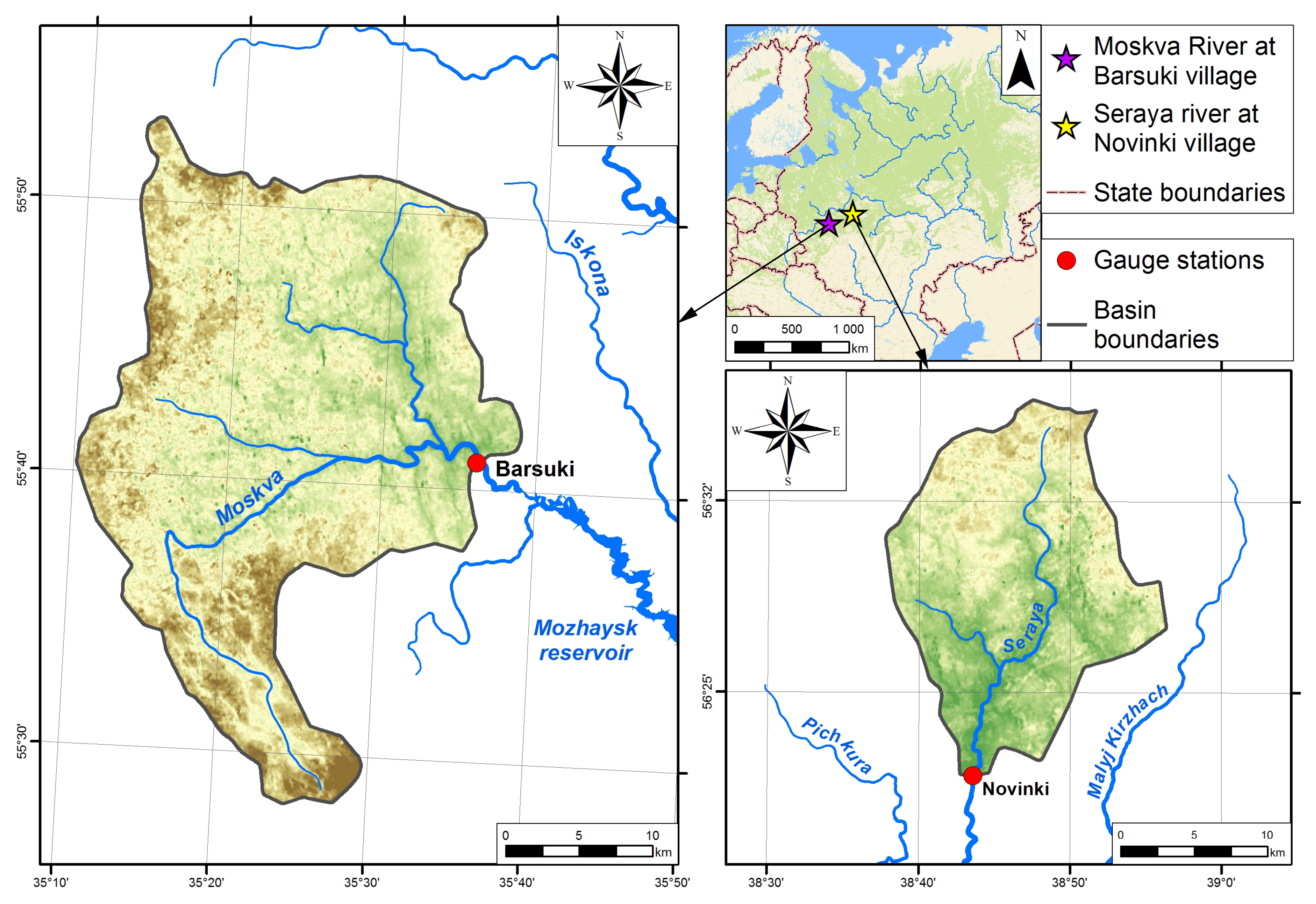
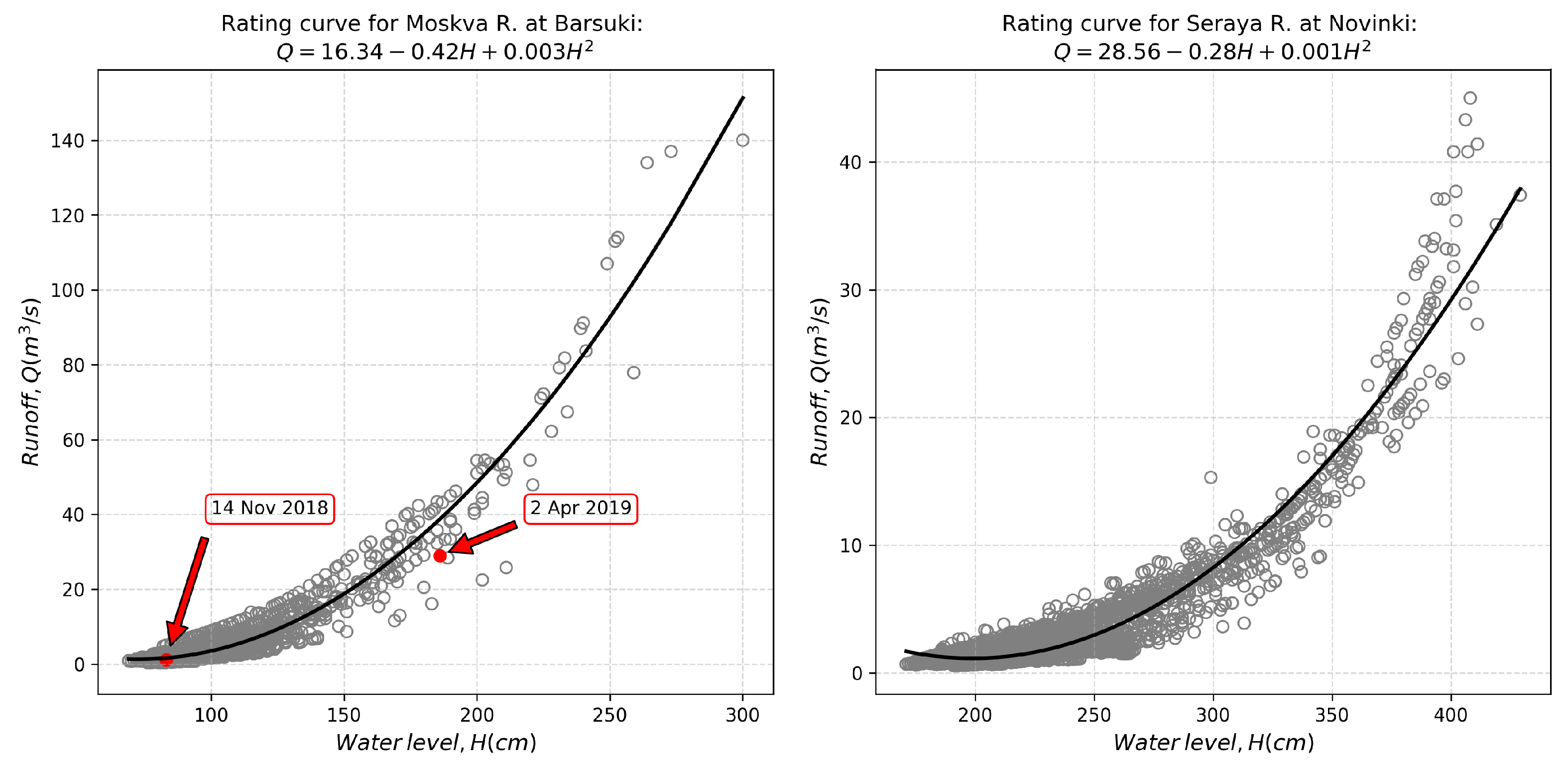
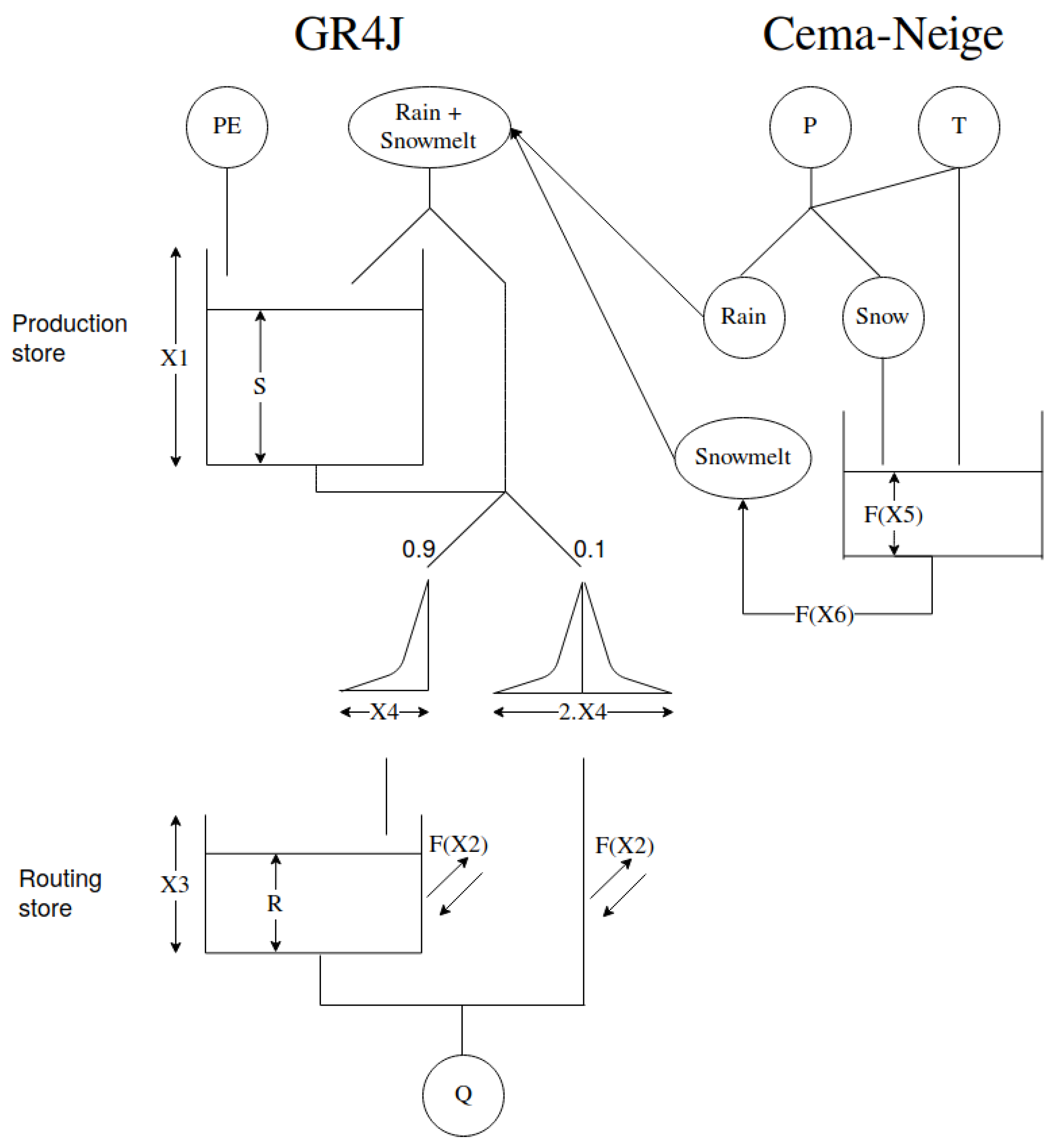
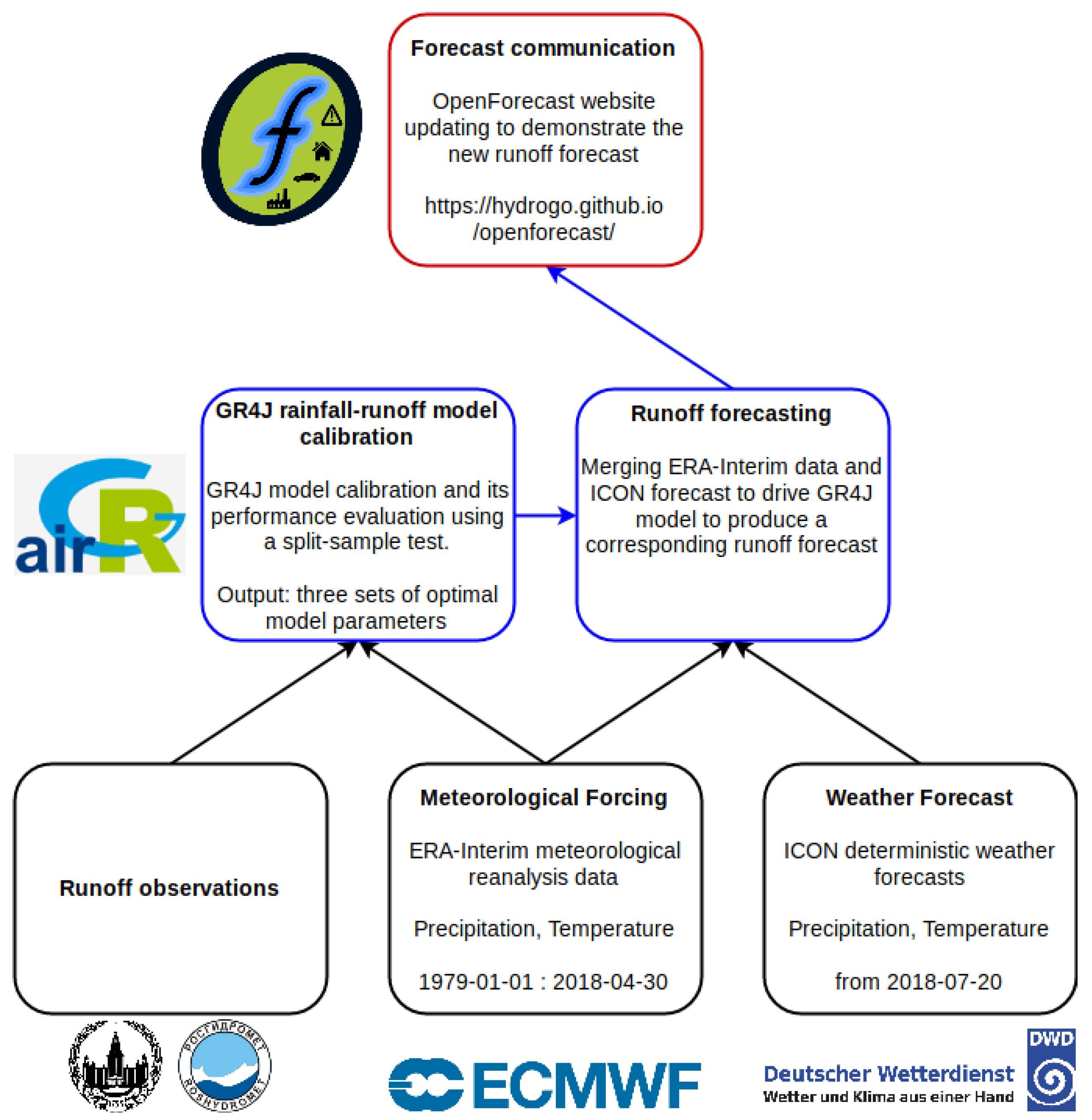


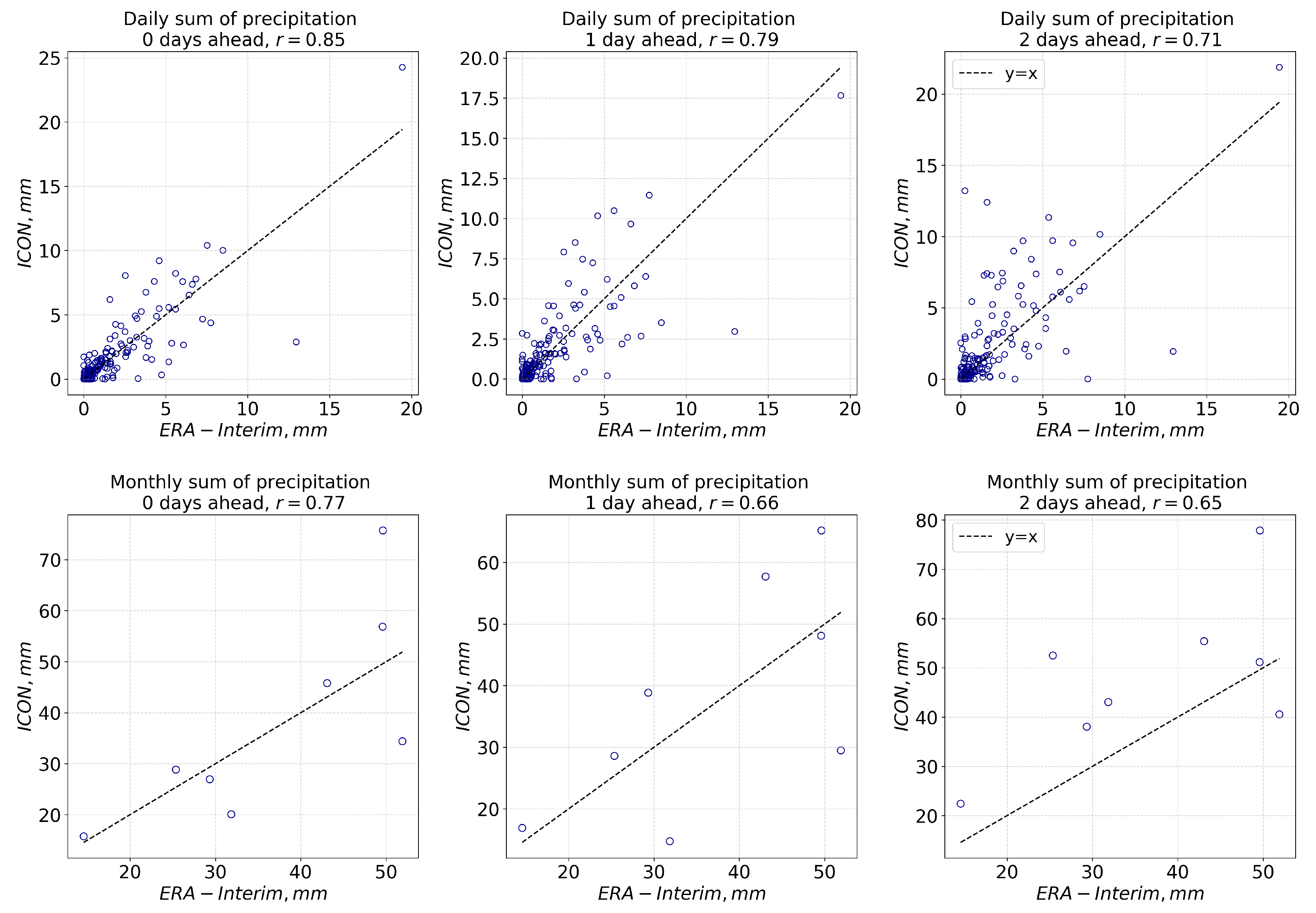


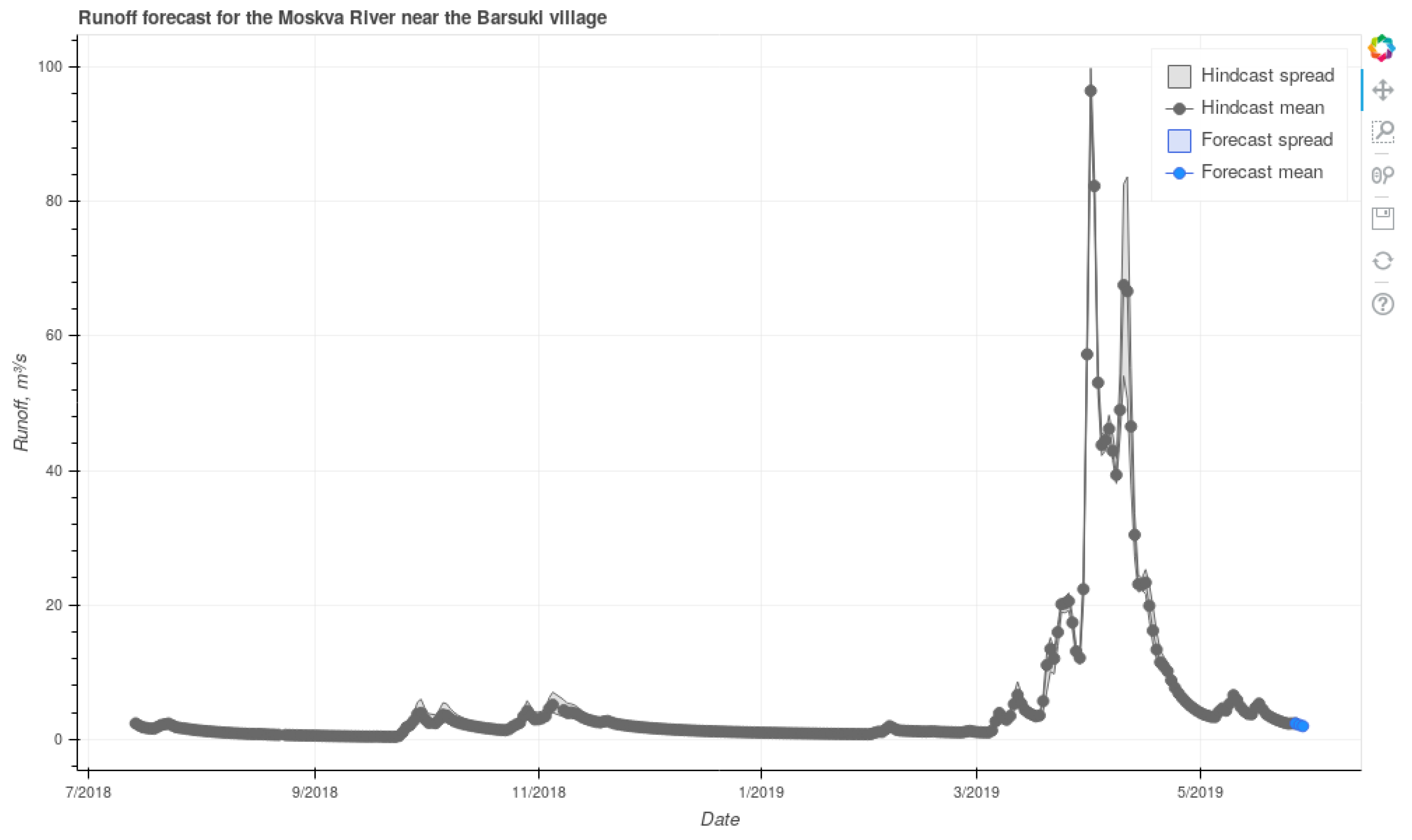

| GR4J | ||
|---|---|---|
| Parameters | Description | Calibration Range |
| X1 | Production store capacity (mm) | 0–3000 |
| X2 | Intercatchment exchange coefficient (mm/day) | −10–10 |
| X3 | Routing store capacity (mm) | 0–1000 |
| X4 | Time constant of unit hydrograph (day) | 0–20 |
| Cema-Neige | ||
| X5 | Dimensionless weighting coefficient of the snowpack thermal state | 0–1 |
| X6 | Day-degree rate of melting (mm/(day*C)) | 0–10 |
| Moskva R. at Barsuki | |||
| Periods for: | Validation (in Columns) | ||
| Calibration (in Rows) | 1979–1985 | 1986–1991 | 1979–1991 |
| 1979–1985 | 0.77/2.8 | 0.75/−6.6 | 0.78/−1.6 |
| 1986–1991 | 0.66/12 | 0.79/2.1 | 0.75/7.5 |
| 1979–1991 | 0.76/6 | 0.78/−3.5 | 0.79/1.6 |
| Seraya R. at Novinki | |||
| Periods for: | Validation (in Columns) | ||
| Calibration (in Rows) | 2003–2009 | 2010–2015 | 2003–2015 |
| 2003–2009 | 0.76/−10 | 0.62/−26 | 0.69/−17 |
| 2010–2015 | 0.61/16 | 0.77/−11 | 0.7/3.5 |
| 2003–2015 | 0.72/−5.2 | 0.75/−24 | 0.74/−14 |
| Moskva R. at Barsuki | Seraya R. at Novinki | |||||
|---|---|---|---|---|---|---|
| Parameters | 1979–1985 | 1986–1991 | 1979–1991 | 2003–2009 | 2010–2015 | 2003–2015 |
| X1 | 110 | 113 | 81 | 240 | 262 | 384 |
| X2 | −0.1 | 0.1 | 0 | −3 | −0.8 | −2.1 |
| X3 | 48 | 33 | 37 | 65 | 51 | 55 |
| X4 | 2.3 | 2.4 | 2.4 | 2.3 | 2.3 | 2.4 |
| X5 | 0.8 | 0.8 | 0.8 | 0.9 | 0.9 | 0.9 |
| X6 | 3.9 | 2.9 | 3.4 | 2.9 | 2.1 | 2.2 |
| Basin | 0 Days Ahead | 1 Day Ahead | 2 Days Ahead |
|---|---|---|---|
| Moskva R. at Barsuki | −0.48/43 | −0.48/43 | −0.51/45 |
| Seraya R. at Novinki | 0.18/−37 | 0.18/−37 | 0.19/−38 |
| Basin | 0 Days Ahead | 1 Day Ahead | 2 Days Ahead |
|---|---|---|---|
| Moskva R. at Barsuki | 0.91/−0.1 | 0.91/0 | 0.90/1 |
| Seraya R. at Novinki | 0.89/2.6 | 0.89/2.6 | 0.89/2.9 |
© 2019 by the authors. Licensee MDPI, Basel, Switzerland. This article is an open access article distributed under the terms and conditions of the Creative Commons Attribution (CC BY) license (http://creativecommons.org/licenses/by/4.0/).
Share and Cite
Ayzel, G.; Varentsova, N.; Erina, O.; Sokolov, D.; Kurochkina, L.; Moreydo, V. OpenForecast: The First Open-Source Operational Runoff Forecasting System in Russia. Water 2019, 11, 1546. https://doi.org/10.3390/w11081546
Ayzel G, Varentsova N, Erina O, Sokolov D, Kurochkina L, Moreydo V. OpenForecast: The First Open-Source Operational Runoff Forecasting System in Russia. Water. 2019; 11(8):1546. https://doi.org/10.3390/w11081546
Chicago/Turabian StyleAyzel, Georgy, Natalia Varentsova, Oxana Erina, Dmitriy Sokolov, Liubov Kurochkina, and Vsevolod Moreydo. 2019. "OpenForecast: The First Open-Source Operational Runoff Forecasting System in Russia" Water 11, no. 8: 1546. https://doi.org/10.3390/w11081546
APA StyleAyzel, G., Varentsova, N., Erina, O., Sokolov, D., Kurochkina, L., & Moreydo, V. (2019). OpenForecast: The First Open-Source Operational Runoff Forecasting System in Russia. Water, 11(8), 1546. https://doi.org/10.3390/w11081546




